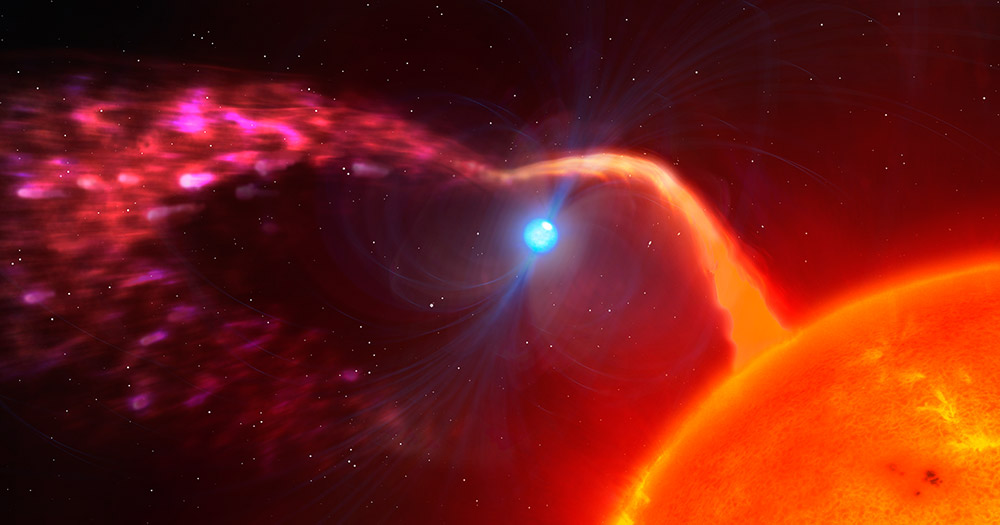Star remnants as fans: Astronomers discover the fastest rotating white dwarf. Remnants of stars roughly the size of Earth need only 25 seconds to spin – that’s 20 percent faster than the previous record holder. Even more strange, however, is that the white dwarf absorbs material from its stellar neighbor, but cannot carry it, instead spewing it at high speed into near space. That makes it only the second known “driving star,” the team says.
White dwarfs are the extremely dense remnants of stars that remain after a Sun-like star collapses and expels its atmosphere. Most of them are rather small and continue to subside over time. However, there are also some white dwarfs that exhibit unusual traits. This includes especially heavy repsr with strong magnetic fields, especially fast-spinning white dwarfs and a handful of star remnants in binary star systems, fast and powerful systems flashes of rays give it – probably caused by the interactions of its magnetic field with substances absorbed by the partner.
A twinkle from a binary star system
Astronomers working with Ingrid Bellisoli of the University of Warwick have now discovered a new record carrier among fast-moving white dwarfs. The focus of their study was the system LAMOST J024048.51 + 195226.9, J0240 + 1952 for short, which was only discovered in 2020. It consists of a red dwarf and a white dwarf approximately the size of the Earth 200,000 times heavier than the Earth. These remnants of stars are observed because they also generate periodic radiation pulses in almost all wavebands.
Beyond the strange flickering of the white dwarf, Bellisoli and her colleagues have now examined more closely with the help of the HiPERCAM instrument at Gran Telescopio Canarias in La Palma. The combination of the ten-meter mirror telescope and the instrument designed for high temporal resolution enabled the team to record and analyze the system’s precise optical curves.
Fastest spin known to date
The result: Part of the flickering is due to the extremely fast rotation of the white dwarf. As astronomers determined, the remnant of the star rotates in just 24.93 seconds – an absolute record. “To date, only three other systems with rotation periods of less than 40 seconds are known,” the team explains. However, the J0240+ 1952 spins 20 percent faster than the fastest among them to date.
“The rotation of this white dwarf is so fast that its mass must be above average to not be torn apart by it,” says Pelisoli. “In the short time it takes to read this book, it has already made so many revolutions – that’s really unbelievable.”
The white dwarf is the star of the fan
The second feature of this white dwarf is even more exciting: it can be only the second known “impulse star”. Astronomers have given this nickname to a white dwarf in the binary star system AE Aquarii, about 300 light-years away, because it is so magnetized and spins too fast to hold material extracted from the partner star: it bombards it inward at tremendous speed and produces additional bursts of radiation.
“Matter gets absorbed, but as it gets close to the white dwarf, its magnetic fields start to dominate,” Pelisoli explains. Combined with the high speed of rotation, this ensures that a large part of the material is disposed of at a speed of more than 3,000 kilometers per second – like mud from a rapidly rotating propeller.
No more isolated cases
“For more than seven decades, AE Aquarii has been alone among the thousands of star systems known to have these unusual properties,” the astronomers wrote. “But that could have changed now.” Because the high speed of rotation and light curves of the J0240 + 1952 glow indicate that this white dwarf could also be like a “fan system”. For the first time, AE Aquarii is no longer alone.
“It’s only the second time we’ve found one of these magnetic propeller systems. So we now know that the AE Aquarii was not an isolated incident,” says co-author Tom Marsh from the University of Warwick. “Instead, this fan mechanism proves to be a feature that can occur in such dual systems under certain conditions.”
This is also important because you can now check the model you developed based on the first case directly in the second case study. “But our current finding shows that the model works well,” Marsh said. (Notes of the Royal Astronomical Society: Letters, 2021; doi: 10.1093/mnrasl/slab116)
Coyle: University of Warwick

“Total coffee aficionado. Travel buff. Music ninja. Bacon nerd. Beeraholic.”







More Stories
“His presence speaks powerfully.”
Experts informed patients about the topic of cervical cancer
'Gaia BH3': A massive black hole lurks here – a falling star that led to the discovery